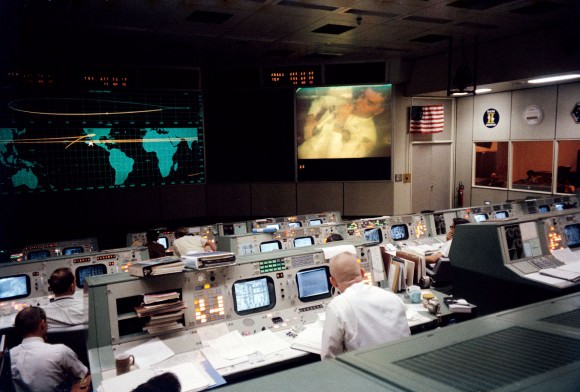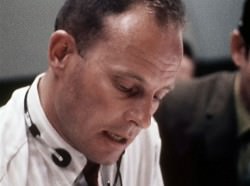To celebrate the 45th anniversary of the Apollo 13 mission, Universe Today is featuring “13 MORE Things That Saved Apollo 13,” discussing different turning points of the mission with NASA engineer Jerry Woodfill.
During the first two days of the Apollo 13 mission, it was looking like this was going to be the smoothest flight of the program. As Capcom Joe Kerwin commented at 46:43 Mission Elapsed Time (MET), “The spacecraft is in real good shape as far as we are concerned. We’re bored to tears down here.”
Everything was going well, and in fact the crew was ahead of the timeline. Commander Jim Lovell and Lunar Module Pilot Fred Haise had entered the Aquarius Lunar Module 3 hours earlier than the flight plan had scheduled, wanting to check out the pressure in the helium tank – which had given some erroneous readings in ground tests before the launch. Everything checked out OK.
Opening up Aquarius early may have been one more thing that saved Apollo 13, says NASA engineer Jerry Woodfill.
“The first time the hatches between both vehicles are opened is a time consuming process,” Woodfill told Universe Today. “It’s as though a bank teller is requested to provide a customer access to a safety deposit box behind two locked vault doors.”
The removable hatch in the Odyssey Command Module had to be tied down and stowed before entering the tunnel for access to the second door, the lander’s entry hatch. Time was required for pressure equalization process so that the tunnel, command ship and lander were at one uniform pressure.
Often, there was a putrid, burnt insulation odor when the hatch to the LM was first opened, as previous crews described, so normally time was allowed for the smell to dissipate. All of these tasks were dealt with by about 55 hours MET, much earlier than originally planned. For some reason, the LM Pilot even brought the lander’s activation check list back into the command ship for study, though activation was scheduled hours away.
“Perhaps, this would be Fred Haise’s bedtime book to read preparing himself for sleep,” Woodfill said.

But first, the crew provided a 49-minute TV broadcast showing how easily they moved about in weightlessness in the cramped spacecraft.
Then, it happened. Nine minutes later, at 55:54:56 MET, came the explosion of the oxygen tank in the Service Module. Despite ground and crew efforts to understand the problem, confusion reigned.
13 minutes after the explosion, Lovell looked out one of Odyssey’s windows and reported, “We are venting something out into space,” and quickly the crew and ground controllers knew they were losing oxygen. Without oxygen, the fuel cells that provided all the power to the CM would die. Tank 2, of course, was gone with the explosion and the plumbing on Tank 1 was severed, so the oxygen was bleeding off from that tank, as well.

At that point, only fifteen minutes of power remained in the Command Module.
“Fifteen minutes more and the entire assemblage might have been a corpse with no radio, no guidance, no oxygen flowing into the cabin to keep Lovell, Haise and Swigert alive,” said Woodfill. “Certainly, it was fortuitous circumstances that led to opening the LM early. Simply consider how much time it would have taken to remove both hatches, stabilize and inspect the tunnel and lander interior. Add to this the time required to power up the lander’s life support systems. As it was, they had an open pathway into a safe haven, a lifeboat, called the lunar lander, crucial to survival.”
If the LM had not been opened, the crew would have likely run out of time before the Command Module’s batteries died, which would have created several problems.
As we discussed five years ago in one of the original “13 Things” articles, all the guidance parameters which would help direct the ailing ship back to Earth were in Odyssey’s computers, and needed to be transferred over to Aquarius. Without power from the fuel cells, they kept the Odyssey alive by using the reentry batteries as an emergency measure. These batteries were designed to be used during reentry when the crew returned to Earth, and were good for limited number of hours during the time the crew would jettison the Service Module and reenter with only the tiny Command Module capsule.
“Those batteries were not ever supposed to be used until they got ready to reenter the Earth’s atmosphere,” said Woodfill. “If those batteries had been depleted, that would have been one of the worst things that could have happened. The crew worked as quickly as they could to transfer the guidance parameters, but any extra time or problem, and we could have been without those batteries. Those batteries were the only way the crew could have survived reentry. This is my take on it, but the time saved by not having to open up the Lunar Module helped those emergency batteries have just enough power in them so they could recharge them and reenter.”
By 58:40 MET, the guidance information from the Command Module computer had been transferred to the LM guidance system, the LM was fully activated and the Command and Service Module systems were turned off.
Mission Control and the crew had successfully managed the first of many “seat of the pant” procedures they would need to do in order to bring the crew of Apollo 13 back home.
Additional articles in this series:
Part 1: The Failed Oxygen Quantity Sensor
Part 2: Simultaneous Presence of Kranz and Lunney at the Onset of the Rescue
Part 3: Detuning the Saturn V’s 3rd Stage Radio
Part 4: Early Entry into the Lander
Part 5: The CO2 Partial Pressure Sensor
Part 6: The Mysterious Longer-Than-Expected Communications Blackout
Part 7: Isolating the Surge Tank
Part 8: The Indestructible S-Band/Hi-Gain Antenna
Part 10: ‘MacGyvering’ with Everyday Items
Part 11: The Caution and Warning System
Part 12: The Trench Band of Brothers
Find all the original “13 Things That Saved Apollo 13″ (published in 2010) at this link.


All the people of Earth were thinking, hoping and praying for those three astronauts after the news of the explosion was broadcast. I am convinced that the reason they made it back was BECAUSE all those people, filled with hope, were thinking about them…. and that SPIRIT moved across the vacuum to intervene…